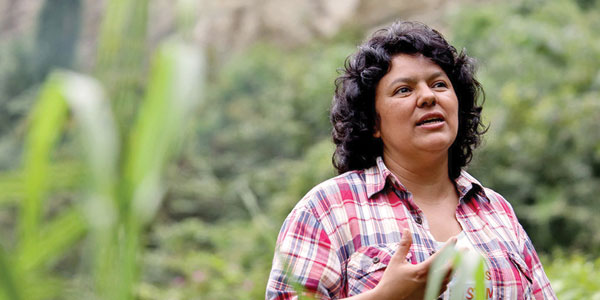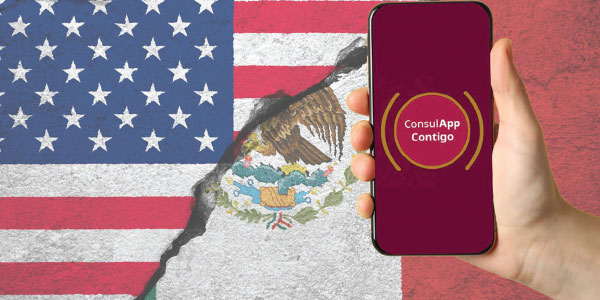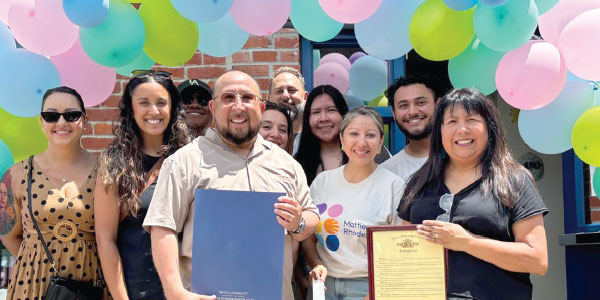
Veo en la pantalla de televisión a la hija de la activista hondureña Berta Cáceres y no lo puedo creer: hace apenas unas semanas que mataron a su madre y Berta Isabel Zúñiga está ahí, firme, dando una entrevista vía satélite desde Washington, sin soltar una sola lágrima, exigiendo justicia. Berta Isabel tiene apenas 25 años de edad pero, sin duda, le enseñaron a luchar desde pequeña.
¿Quién mató a tu mamá? le pregunto. “Ella fue asesinada en su casa”, me cuenta. Berta Cáceres, la ambientalista de 45 años de edad y líder de la comunidad indígena lenca, vivía en La Esperanza, al oeste de Honduras. “Sabemos que por lo menos entraron dos sicarios a asesinarla”.
Algunos periodistas jugaron irresponsablemente con las especulaciones de que fue un intento de robo o un crimen pasional. Pero Berta Isabel dice que eso no es cierto. Ella cree que la muerte de su madre podría estar ligada, supuestamente, a la construcción de una gigantesca represa que logró bloquear de manera temporal en el río Gualcarque. Y también al “gobierno de Honduras, que fue incapaz de garantizar las medidas cautelares que ella tenía desde el 2009”. (La empresa hidroeléctrica Agua Zarca, en un comunicado que me enviaron, niega cualquier “vinculación, directa o indirecta” en la muerte de Berta Cáceres, “lamenta y condena el crimen”, “se solidariza con la familia doliente” y “repudia todo tipo de actos que atenten en contra de la vida de las personas”.)
La verdad es que Berta Cáceres — la coordinadora del Consejo Cívico de Organizaciones Populares e Indígenas de Honduras — vivió los últimos años de su vida como una mujer al borde de la muerte. Recibió múltiples amenazas por su oposición a la creación de una planta hidroeléctrica, con fuerte financiamiento internacional, que afectaría irremediablemente el medio ambiente, las tierras de cultivo en la zona y varios ríos considerados sagrados por la mayor etnia indígena del país. Se suponía que el gobierno hondureño debía protegerla. Claramente, eso no ocurrió.
Berta Cáceres se dio a conocer al mundo por recibir el premio Goldman en abril del 2015 por su protección al medio ambiente en Honduras. Entonces le dijo en una entrevista a la BBC que “nos consideramos custodios de la naturaleza, de la tierra y, sobre todo, de los ríos”.
El único testigo presencial del asesinato de Berta Cáceres es el ambientalista mexicano Gustavo Castro. “Él estaba en la casa, en el cuarto de mi hermana menor, acompañando a mi mamá esa noche”, me contó Berta Isabel. “El se salva de milagro… el sicario le apuntó directamente a la cara, él movió la cara y la bala le rozó una mano y le cortó parte de su oreja”. El sicario aparentemente lo dio por muerto y se fue.
Poco después, en una conferencia de prensa, Castro fue muy claro. “Estamos todos esperando que el mismo gobierno pueda ofrecer una versión creíble”, dijo. “Una versión que satisfaga a la familia de Berta”. Esa versión no ha llegado todavía.
¿Confías en la justicia en Honduras? le preguntó a Berta Isabel. “No, nosotros no confiamos porque ha sido un aparato ineficiente en la investigación”, me asegura. “Pero, también porque la institucionalidad hondureña tenía intereses fuertes en no averiguar quiénes de verdad están detrás de su asesinato”. Por eso ella está pidiendo que sea la Comisión Interamericana de Derechos Humanos, con expertos independientes, quienes investiguen la muerte de su madre.
Berta Isabel y sus tres hermanos saben que ellos pudieran ser los siguientes. “Sí, y la amenaza viene por exigir justicia y ahora convertirnos en voceros”, me dijo, firme, sin titubear. La veo en la pantalla de televisión y no noto ninguna fisura. Su gesto es casi de enojo y de mucha determinación. Berta Isabel ha dejado el duelo para después. Este, para ella, no es momento de llorar. Este es momento de luchar. Eso lo aprendió de su madre. Sólo cuando se refiere a ella como “mi mami” es que sabemos que carga un intenso dolor. Y ella sabe que pelear contra una injusticia es otra forma de recordarla y quererla. (Aquí puedes ver la entrevista con Berta Isabel: bit.ly/23Cao4q.)
En su discurso de aceptación del premio Goldman, Berta Cáceres dijo que “la defensa de los ríos es dar la vida para el bien de la humanidad y de este planeta”. Así vivió, y así murió.
Menos de un año después de pronunciar esas palabras, Berta Cáceres fue enterrada cerca del río Gualcarque que tanto amaba.
(Jorge Ramos, periodista ganador del Emmy, es el principal director de noticias de Univisión Network. Ramos, nacido en México, es autor de nueve libros de grandes ventas, el más reciente de los cuales es “A Country for All: An Immigrant Manifesto”.)
Who Killed Berta Cáceres?
I recently spoke with Berta Isabel Zúñiga, daughter of the late Honduran environmental activist Berta Cáceres, via satellite from Washington. As I was watched Zúñiga on the screen, it occurred to me that this 25-year-old must have inherited her mother’s fighting instincts. Though Cáceres was killed just a few weeks ago, here was Zúñiga, answering questions on television and demanding justice for her mother, without shedding a single tear.
Cáceres, 44, head of the Civic Council of Popular and Indigenous Organizations of Honduras, was best known for leading the Lenca community’s opposition to the construction of a major dam on the Gualcarque River. The dam, backed by a significant amount of international funding, would irremediably affect the environment, destroy farmland and block access to rivers considered sacred by indigenous groups.
On March 3, gunmen broke down Cáceres’ front door and shot her to death.
Some journalists in Honduras speculated that the killing was either a robbery gone wrong or a crime of passion. But Zúñiga believes that her mother’s death might be tied to her activism against the Gualcarque dam. So far a police investigation has led nowhere. (Agua Zarca, the hydroelectric firm building the dam, said in a news release that the company had no “direct or indirect link” to Cáceres’ death. The company also said that it “bemoans and condemns the crime” and “expresses its solidarity with the mourning family.”)
Cáceres lived her last years on the brink of death. Her outspoken opposition to the dam led to many threats against her life. The Honduran government, aware of the threats, was supposed to protect Cáceres — but failed.
The sole eyewitness to Cáceres’ killing was a guest, Gustavo Castro, a Mexican environmentalist. “He was in the house that night, in my little sister’s room, visiting my mother,” Zúñiga told me. “It was a miracle that he was spared … The gunman aimed directly at his face, but he moved his head and the bullet only hit his hand and clipped part of his ear.” Apparently the gunman thought Castro was dead and left.
At a news conference soon afterward, Castro said that he was frustrated that government investigators have come up with no explanation of who the gunmen were or why Cáceres was targeted. “We are waiting for the government itself to come up with a credible [story],” he said. “A version that satisfies Berta’s family.”
During my interview, I asked Zúñiga if she trusts that the Honduran government will bring her mother’s killers to justice. “No. We don’t have faith in the government. First, because it’s been inefficient with regard to the investigation
but also because the Honduran establishment has a strong interest in not investigating and not finding out who was really behind her murder.” That’s why Zúñiga is asking the Inter-American Commission for Human Rights to assist in the investigation.
Zúñiga and her three brothers know they could be the next victims of her mother’s killers, “now that we’re demanding justice and raising our voices,” she said. But they are undeterred.
During our discussion, Zúñiga was stoic. This is no time for tears. It’s time to fight. That’s what she learned from her mother. Only when she refers to her mother as “mami” during our talk does she let on that she’s bearing a great burden of grief. But she knows that fighting against injustice is a way of honoring her mother. (You can watch my interview in Spanish with Zúñiga here: bit.ly/23Cao4q.)
In April 2015, Cáceres received the Goldman Prize, a prestigious award honoring grass-roots environmentalism, for her efforts to protect the environment in Honduras. During her acceptance speech, Cáceres said that giving our lives for the protection of the rivers
is giving our lives for the well-being of humanity and this planet.”
Less than a year later, Cáceres was buried near the Gualcarque River that she loved.
(Jorge Ramos, an Emmy Award-winning journalist, is a news anchor on Univision and the host of “America With Jorge Ramos” on Fusion. Originally from Mexico and now based in Florida, Ramos is the author of several best-selling books. His latest is “Take a Stand: Lessons From Rebels.” Email him at jorge.ramos@nytimes.com.)










